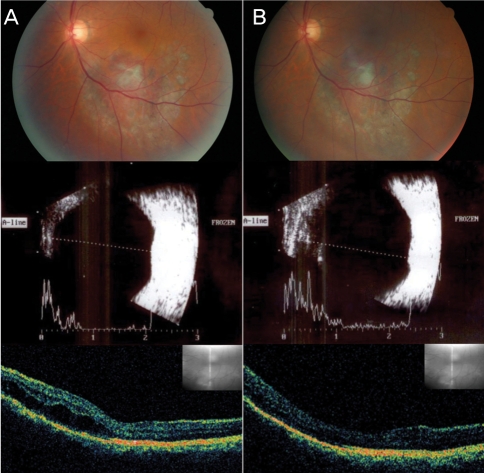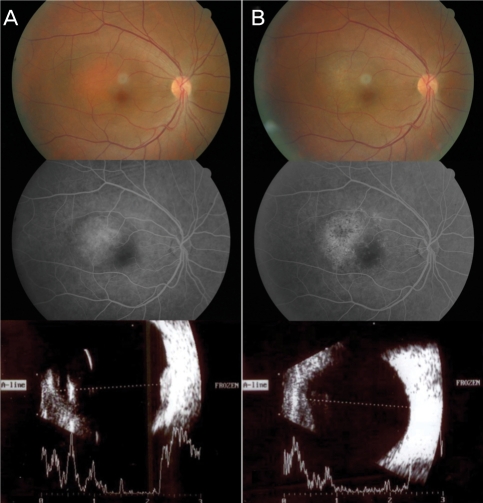Korean J Ophthalmol.
2009 Jun;23(2):127-131. 10.3341/kjo.2009.23.2.127.
Application of Intravitreal Bevacizumab for Circumscribed Choroidal Hemangioma
- Affiliations
-
- 1Department of Ophthalmology, Yeungnam University College of Medicine, Daegu, Korea. changwh@ynu.ac.kr
- KMID: 754733
- DOI: http://doi.org/10.3341/kjo.2009.23.2.127
Abstract
- We report 3 cases of circumscribed choroidal hemangioma (CCH) effectively managed with intravitreal bevacizumab. One patient (case 1) who had recurrent CCH (1.6 mm in thickness) with prior laser photocoagulation was treated with intravitreal bevacizumab alone. Two patients (case 2 and 3) who had CCH (2.4 mm and 2.2 mm in thickness, respectively) with recent visual impairment were treated with bevacizumab followed by photodynamic therapy (PDT). Ophthalmic evaluations included visual acuity, ophthalmoscopic examination, fluorescein angiography, ultrasonography, and optical coherence tomography. Patients were followed up for 6-9 months. After therapy, all patients showed improved visual acuity due to complete resorption of subretinal fluid and macular edema. Ultrasonography demonstrated a reduction of the thickness of CCH in case 1 and complete regression of the lesions in case 2 and 3. No patient showed tumor recurrence. Intravitreal bevacizumab, alone or in combination therapy with PDT, may be a useful alternative for the treatment of symptomatic CCH with subretinal fluid.
MeSH Terms
-
Angiogenesis Inhibitors/*administration & dosage
Antibodies, Monoclonal/*administration & dosage
Choroid Neoplasms/diagnosis/*drug therapy
Diagnosis, Differential
Female
Follow-Up Studies
Hemangioma/diagnosis/*drug therapy
Humans
Injections
Male
Middle Aged
Ophthalmoscopy
Tomography, Optical Coherence
Vascular Endothelial Growth Factor A
Vitreous Body
Figure
Cited by 1 articles
-
Treatment Outcome of Serous Macular Detachment in Circumscribed Choroidal Hemangioma
Jeong Min Kwon, Seung Min Lee, Han Jo Kwon, Sung Who Park, Ji Eun Lee, Ik Soo Byon
J Korean Ophthalmol Soc. 2017;58(3):289-295. doi: 10.3341/jkos.2017.58.3.289.
Reference
-
1. Green WR. Spencer WH, editor. Uveal tract. Ophthalmic Pathology: An Atlas and Textbook. 1986. v. 3:3 rd ed. Philadelphia: Saunders;chap. 9.2. Witschel H, Font RL. Hemangioma of the choroid. A clinicopathologic study of 71 cases and a review of the literature. Surv Ophthalmol. 1976; 20:415–431. PMID: 820013.
Article3. Mashayekhi A, Shields CL. Circumscribed choroidal hemangioma. Curr Opin Ophthalmol. 2003; 14:142–149. PMID: 12777933.
Article4. Anand R, Augsburger JJ, Shields JA. Circumscribed choroidal hemangiomas. Arch Ophthalmol. 1989; 1107:1338–1342. PMID: 2783066.
Article5. Augsburger JJ, Shields JA, Moffat KP. Circumscribed choroidal hemangiomas: long-term visual prognosis. Retina. 1981; 1:56–61. PMID: 15633407.6. Shields CL, Honavar SG, Shields JA, et al. Circumscribed choroidal hemangioma: clinical manifestations and factors predictive of visual outcome in 200 consecutive cases. Ophthalmology. 2001; 108:2237–2248. PMID: 11733265.
Article7. Sanborn GE, Augsburger JJ, Shields JA. Treatment of circumscribed choroidal hemangiomas. Ophthalmology. 1982; 89:1374–1380. PMID: 6891765.
Article8. Humphrey WT. Choroidal hemangioma: Response to cryotherapy. Ann Ophthalmol. 1979; 11:100–104. PMID: 420470.9. Chao AN, Shields CL, Shields JA, Krema H. Plaque radiotherapy for choroidal hemangioma with total retinal detachment and iris neovascularization. Retina. 2001; 21:682–684. PMID: 11756902.
Article10. Ritland JS, Eide N, Tausjo J. External beam irradiation therapy for choroidal haemangiomas: visual and anatomical results after a dose of 20 to 25 Gy. Acta Ophthalmol Scand. 2001; 79:184–186. PMID: 11284760.
Article11. Guyer DR, Mukai S, Egan KM, et al. Radiation maculopathy after proton beam irradiation for choroidal hemangioma. Ophthalmology. 1992; 99:1278–1285. PMID: 1325044.12. Furst CJ, Lundell M, Holm LE, Silfverswärd C. Cancer incidence after radiotherapy for skin hemangioma: a retrospective cohort study in Sweden. J Natl Cancer Inst. 1988; 80:1387–1392. PMID: 3172265.
Article13. Garcia-Arumi J, Ramsay LS, Guraya BC. Transpupillary thermotherapy for circumscribed choroidal hemangiomas. Ophthalmology. 2000; 107:351–356. PMID: 10690838.
Article14. Barbazetto I, Schmidt-Erfurth U. Photodynamic therapy of choroidal hemangioma: two case reports. Graefes Arch Clin Exp Ophthalmol. 2000; 238:214–221. PMID: 10796035.
Article15. Schmidt-Erfurth UM, Michels S, Kusserow C, et al. Photodynamic therapy for symptomatic choroidal hemangioma: visual and anatomic results. Ophthalmology. 2002; 109:2284–2294. PMID: 12466172.16. Porrini G, Giovannini A, Amato G, et al. Photodynamic therapy of circumscribed choroidal hemangioma. Ophthalmology. 2003; 110:674–680. PMID: 12689885.
Article17. Michels S, Michels R, Simader C, Schmidt-Erfurth U. Verteporfin therapy for choroidal hemangioma: a long-term follow-up. Retina. 2005; 25:697–703. PMID: 16141856.
Article18. Rosenfeld PJ, Schwartz SD, Blumenkranz MS, et al. Maximum tolerated dose of a humanized anti-vascular endothelial growth factor antibody fragment for treating neovascular age-related macular degeneration. Ophthalmology. 2005; 112:1048–1053. PMID: 15885778.
Article19. Mason JO 3rd, Nixon PA, White MF. Intravitreal injection of bevacizumab (Avastin) as adjunctive treatment of proliferative diabetic retinopathy. Am J Ophthalmol. 2006; 142:685–688. PMID: 17011869.
Article20. Rosenfeld PJ, Moshfeghi AA, Puliafito CA. Optical coherence tomography findings after an intravitreal injection of bevacizumab (Avastin) for neovascular age-related macular degeneration. Ophthalmic Surg Lasers Imaging. 2005; 36:331–335. PMID: 16156152.
Article21. Rosenfeld PJ, Fung AE, Puliafito CA. Optical coherence tomography findings after an intravitreal injection of bevacizumab (Avastin) for macular edema form central retinal vein occlusion. Ophthalmic Surg Lasers Imaging. 2005; 36:336–339. PMID: 16156153.22. Haritoglou C, Kook D, Neubauer A, et al. Intravitreal bevacizumab (Avastin) therapy for persistent diffuse diabetic macular edema. Retina. 2006; 26:999–1005. PMID: 17151486.
Article23. Kahook MY, Schuman JS, Noecker RJ. Needle bleb revision of encapsulated filtering bleb with bevacizumab. Ophthalmic Surg Lasers Imaging. 2006; 37:148–150. PMID: 16583638.
Article24. Kenawy N, Groenwald C, Damato B. Treatment of a vasoproliferative tumour with intravitreal bevacizumab (Avastin). Eye. 2007; 21:893–894. PMID: 17347676.
Article25. Ziemssen F, Voelker M, Inhoffen W, et al. Combined treatment of a juxtapapillary retinal capillary haemangioma with intravitreal bevacizumab and photodynamic therapy. Eye. 2007; 21:1125–1126. PMID: 17545966.
Article26. Chung SE, Cho HY, Kim JI, Kang SW. Circumscribed choroidal hemangioma: a report of 7 cases. J Korean Ophthalmol Soc. 2006; 47:368–373.27. Mason JO 3rd, Albert MA, Vail R. Intravitreal bevacizumab (Avastin) for refractory pseudophakic cystoid macular edema. Retina. 2006; 26:356–357. PMID: 16508440.
Article28. Finger PT, Chin K. Anti-vascular endothelial growth factor bevacizumab (Avastin) for radiation retinopathy. Arch Ophthalmol. 2007; 125:751–756. PMID: 17562985.
Article
- Full Text Links
- Actions
-
Cited
- CITED
-
- Close
- Share
- Similar articles
-
- Transpupillary Thermotherapy in Circumscribed Choroidal Hemangioma
- Effect of High-dose Intravitreal Bevacizumab Injection on Refractory Idiopathic Choroidal Neovasculariz
- Laser Photocoaculation Treatment in a Case of Circumscribged Choroidal hmangioma Associated with Serous Retinal Detachment
- Comparison of Intravitreal Bevacizumab and Aflibercept Injections for Central Serous Chorioretinopathy
- A Case of Intravitreal Bevacizumab Injection for the Treatment of Choroidal Neovascularization in Morning Glory Syndrome




